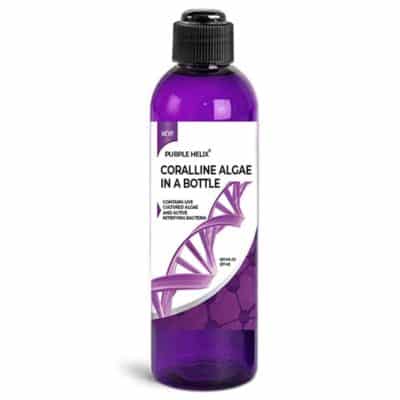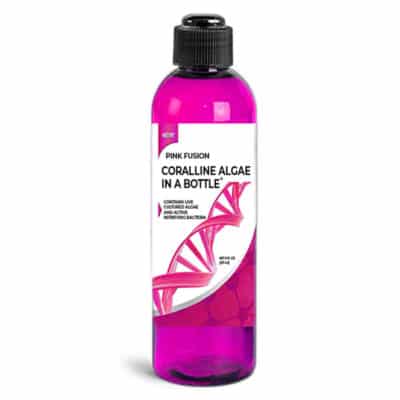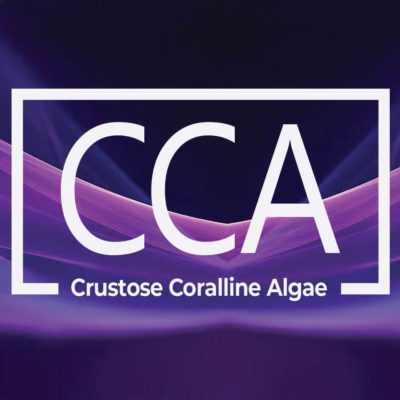What is the Live Rock Curing Process?
Live Rock Curing is the removal of dead and decaying matter from on and within the rocks. This process can occur inside your display tank (if it does not yet contain fish and corals) or in a separate container such as a Rubbermaid trash barrel. The process of cycling your tank and curing your live rock are two separate entities but they can happen together at the same time.
Does all Live Rock need to be Cured?
The short answer is No, not all Live Rock needs to be cured. You will only need to cure your Live or Dry Rock if there is dead or decomposing matter present. You can test this in two ways. The first is the rather unscientific method. Hold your nose up near the rock and smell it. If it smells like the ocean or a jetty at low tide your good to go, if it smells like rotten fish it will need to be cured. The more scientific approach is to place your new live rocks in a container of salt water for 12-24 hours then test for ammonia, if ammonia is high your rocks will need to be cured. If the level is at 0 ppm or barely detectable then no curing is required. Typically all Live Rock from Fiji and the Indo-Pacific will need to be cured due to their long transport duration. Not much life can survive that long out of the water.
Aquacultured Live Rock that is harvested here in the U.S. usually does not need to be cured, as it was happy and alive in the ocean just several days before it lands on your front door. Temperature extremes and shipping duration will be the two influencing factors that determine if Live Rock curing will be needed or not. If you’re having the blizzard of the century your Live Rock could get delayed or stressed out from being in a cold warehouse or truck for too long. So it’s always a good idea to be mindful of your current weather conditions when ordering Live Rock and pick a shipping method that you are comfortable with. Make sure to be home on the day of your delivery or at least make arrangements to have someone bring the package inside if UPS leaves it at your door.
Terms used for Live Rock Curing Stages
Pre Cured Live Rock – The Live Rock originated from another country. It was then shipped to a distributor or fish store in the US and they had it curing for the length of time needed to be ready to go into your aquarium now.
Fully Cured Live Rock – This term is the same as “precured”, they are used interchangeably but they both mean the same thing. It was imported to the US, sat in someones curing tub and is now ready to be placed into your fish tank.
Uncured Live Rock – This term describes Live Rock that was shipped from overseas, usually Fiji, the transport process takes quite a long time, it can take up to 2 months to receive some Live Rock via boat. During this time nearly all life on the rocks will die and the rocks will need to be cured now in order to be able to use them in any aquarium.
Aquacultured Live Rock – This type of Live Rock requires little or no curing at all. It originated from the US and was in the ocean on its farm just days ago. ARC Reef is so passionate about our Live Rock that we have developed a method of harvesting our Live Rock and keeping it submerged underwater for its entire trip from the ocean to our aquaculture facility. Our holding tanks on the boat are even temperature controlled to keep all our Live Rock happy, healthy, and looking great! Here’s a link to our selection of fully Aquacultured Live Rock for Sale.
We have created the chart below to give you a good idea if curing Live Rock will be needed or not for your order. All orders are shipped out from our Miami facility, so the closer you live to Florida, the less likely you will need to go through the process of Live Rock Curing. We have found that if your order takes 4 days or less to receive then 90% of the time you will not need to cure your Live Rocks and they can be placed directly into your tank. If your shipping time is over 4 days, then we recommend a few days of curing. The curing process for aquacultured Live Rock is never as long or as intense as it is for Fiji or Pukani type Live Rock. As a reference we have included below the steps you would need to follow for “non-aquacultured Live Rock”.

How to Cure Live Rock
If your Rocks failed both the smell test and the ammonia test than they will need to be cured. If this is a brand new tank with no inhabitants in it yet, the rocks can be cured in your main display tank. If your tank is already established with fish and corals in it then you will need a separate tank. A Rubbermaid trash can or a children’s kiddie pool work best and are fairly inexpensive. The larger the water volume the better.
- Fill your container 3/4 with fresh saltwater. We recommend making your mix with RO/DI water instead of tap-water. Reverse osmosis deionized water is always the purest option, as city water and well water may contain chlorine, chloramines, phosphates, as well as other unwanted minerals.
- Inspect your Live Rock for dead organic matter and sponges. If it’s black it almost always means that it’s dead and sponges rarely survive this process. Use a medium bristled brush to remove all the dead that you can, then rise them.
- Place your Live Rock in the tank and top off to bring the level near the top.
- You will want to attach a protein skimmer to remove waste, a powerhead for circulation, and a heater to keep the temperature above 80. The more flow and the higher the temperature (without going over 82), the faster the curing process will be.
- Test the water 2-3 times weekly for ammonia and nitrites, this will give you an indicator on how close they are to being done.
- Do a water change any time the ammonia is over 5.0 ppm or it has been more than 5 days since your last water change. It is recommended to do 2 water changes per week, but this is just a guide. If your ammonia is above 10.0ppm, I would suggest more, if your levels are below 5.0 ppm than every 5 days is fine. You can speed up the curing process by scrubbing the rocks with a soft bristle brush immediately before doing each water change.
- Once your ammonia readings are at 0 ppm and your nitrates stop rising, the curing process is now complete and you can transfer your fully cured live rock to your aquarium. This process can take anywhere from 1 week to 2 months, with the exception of pukani dry rock and Fiji boat rock which can take more than 6 months to fully cure.
Tank Lighting During the Curing Process
Do not light your live rocks with full intensity lighting during the curing process as this may cause an algae bloom. Light them with either actinic lighting or natural lighting by having them in a room that gets indirect sunlight. If using actinic lighting, their photo-period should be no more then 5 hours per day. The main goal is to provide the minimum amount of light needed to keep the coralline algae and coral hitchhikers alive, but limited enough to not cause any algae blooms.
The live Rock curing process can be quite a smelly endeavor, you might want to give a little warning to your significant other, otherwise, you may be sleeping with your aquarium for a few nights! Carbon can be used to reduce the smell if needed.
Remember not all Live Rock needs to be cured, if you purchased aquacultured Live Rock harvested in the U.S. you can skip this entire process 90% of the time. It pays to do your research first, and avoid the hassle of curing entirely.
For more information on Live Rock visit our Guide to Live Rock








Lots of really great info. I just bought live rock so I can test this right away, thanks guys and keep up the great work
Wish I had read this about a yr. ago before putting wet and dry live rock from unknown sources in my tank. Been dealing with a hair algae problem since!
Would there be any benefit to letting the ammonia reach its max; then allowing it to build the bacteria that changes the ammonia into nitrite then allowing the bacteria that changes nitrite too nitrate and then do a 100% water change- then place the fully established, cured/cycled rock into your tank.
My dry rock has turned off black and smells of sulfur after 3 weeks in salt water, heat and pumps and 3 water changes. Anaerobic bacteria? What should I do?
Hi Roy, thank you for your comment. It sounds like you’ve purchased dry rock that was formerly live rock, such as pukani or Fiji Dry Rock. While these are called dry rock, they must be treated more like dead live rock since they still have decaying matter on and within the rock. Purchasing these types of rock is not recommended due to the extra steps needed to start using them. For True Dry Rock we only recommend our ARC Reef Dry Rock and Marco Dry Rock. Both of these will come from a quarry of natural limestone. The rocks help buffer your tanks calcium and PH. The rock is located in a freshwater aquifer so they are both impeccably clean and ready to go with no chemicals, nitrites, sulfur, or silicates. If you can still return your dry rock we recommend doing so, if not then reply with where you purchased it and will tell you the next steps such as an acid bath, boiling, and scrubbing, and long duration soaking.
I have some rock that was given to me by my doctor, he gave me his entire 72 gallon bowfront tank, I have the rock in a brute trash can with 1.025 salinity, a 800gph wavemaker, I have tested it, 0ppm ammonia, 5ppm nitrate, 0ppm nitrite, etc, the rock is 100% live, but loaded and I do mean LOADED with pests, especially Aptasia and manjano anemones (I think that’s what they are called) What can I do without having to cook all the rocks for months in the sun and dry them out and re-cure, to help me get rid of the pests completely on the rock? or do I just put it all back in the tank and try hoping peppermint shrimp eat it all or something? I could really use some help here, Thank you, The rocks are the red real reef rocks, about 100 to 150lbs of it. would a freshwater dip help any?
Hi Jame’s, Just wondering what direction you took with your infested rocks as I’m currently in the exact same situation?
Thanks Chief, any advise is apreceated!
This is a to a great extent weighty post. Thanks instead of posting this. Sonia Brucie Grover
Hi, I have about 100lbs of misc Fiji, tonga, etc. (dead) live rock that’s been in my sunlit attic for 6 years. It’s been subjected to 115° plus summer Temps, and low single digit winter temps. K guessing it’s likely dead enough to put directly into a live 4 y/o tank???